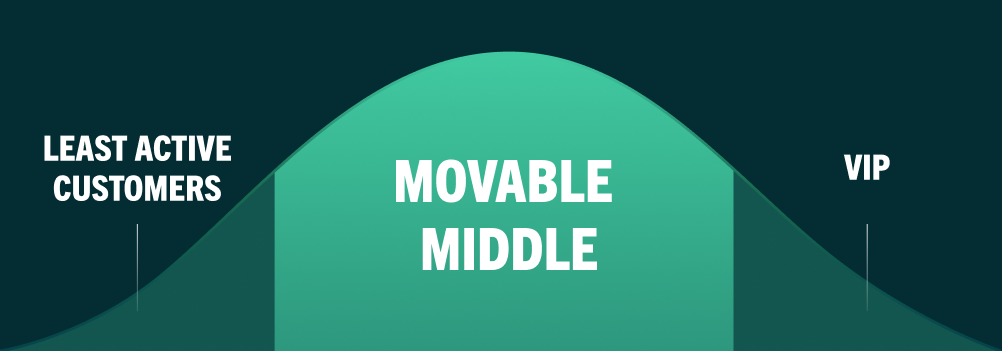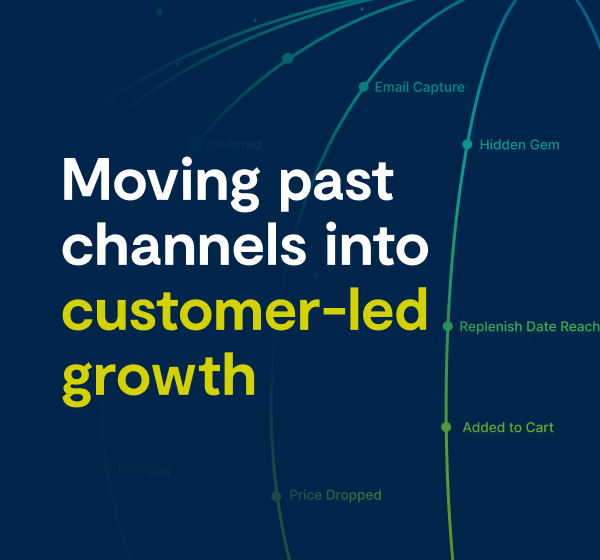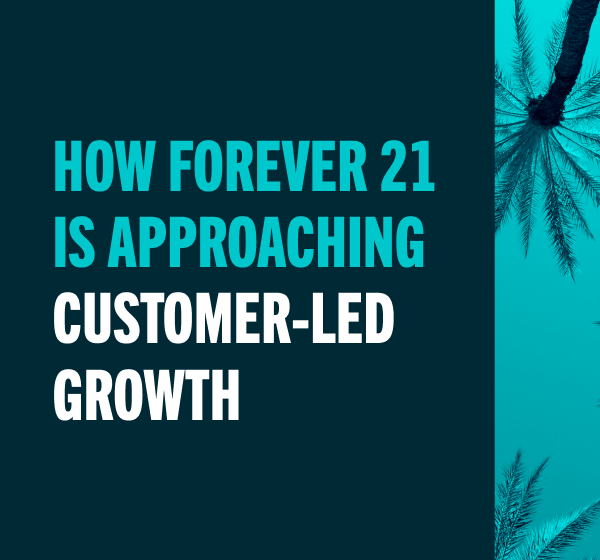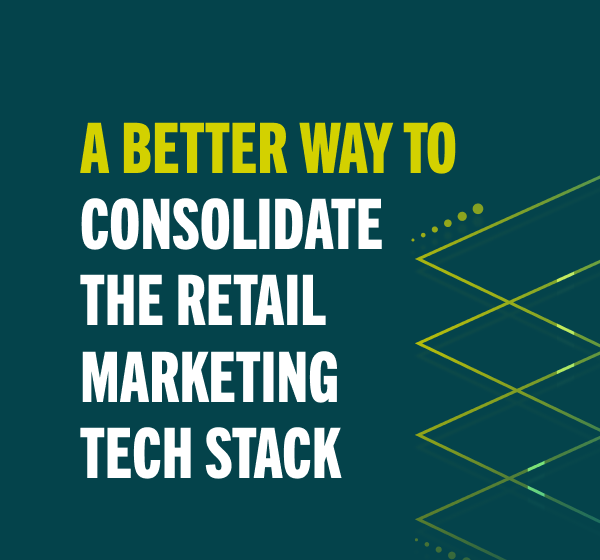
Transforming One-and-Dones into Brand Loyalists: A Retailer’s Guide to the Movable Middle
The one-and-done customer is the bane of a marketer’s existence. You work hard to acquire that customer, and eventually, you get them to convert. Great! Then — well, frankly, they ghost you. And often, these customers vanish before you’ve made back the money spent acquiring them in the first place. Now, they’re sitting in your customer file, doing approximately nothing.
If you market to the very top of your customer file — the VIPs — you know what’s going to happen. Your VIPs could be anywhere from the top 10% to the top 30% of your customer file, and they’re generally your most active buyers. And if you market to them, a fair amount of those customers will buy. That’s awesome. But many of them would have bought from you even if you did absolutely nothing to convince them. So you need to ask how much money, time, and effort you should be spending on them. Are you really making a difference?
The further you get from the extremes — the top and bottom of your file — the less certain the modeling becomes. You just might not have enough data to really understand the customers in the middle of your file, and send them relevant content and offers.
It doesn’t have to be this way.
Meet the movable middle
The middle of your customer file — the folks who are not VIPs, but also not hopeless — is exactly where you have the chance to achieve the biggest ROI with your marketing efforts. It’s the biggest part of your customer file, so it represents the biggest opportunity, and the ability to move your business forward in a significant way. It’s also where you have the greatest uncertainty in predicting how a customer will respond to you. Those two things — potential and uncertainty — are linked.
The movable middle are customers in the middle of your file, who have some distinguishing characteristic that makes them more valuable than they would otherwise appear. With the right technology, you can find those characteristics and signals, use them to build cohorts, and start trying to move them through the funnel. Until you start experimenting, you can’t know what your best tactics will be. But by marketing to the middle, you’re winning sales that would not have happened without your efforts. You know that your gains are incremental — they’re new and they matter.
The promise of the movable middle
When marketers calculate ROAS, they should ideally take the incremental part — the sales that would not have happened without their work — and divide that by the marketing spend. But most marketers use last-click attribution, which means they take their total sales, and divide that by the marketing spend. The result: An artificially inflated ROAS, and wasted marketing dollars.
To successfully move the middle of your customer file, and to create repeat customers where once there appeared to be only a bleak landscape of one-and-dones, you need cultural permission to get away from last-click attribution. You need to focus on incremental gains. Those gains, from the middle of your file, are going to drive your business forward.
Fortunately, you have a head start with customers in the middle: You know who they are, and you know they’ve converted at least once. That purchase gives you some sense of their preferences and affinities. And you likely have the permission and the ability to re-start the conversation with them, whether through email, SMS, or a third-party platform. While these folks may initially look like one-and-dones, they represent real value and the chance to create loyal repeat customers.
While it takes work and some creativity to move the middle, converting customers in the middle of your file is much less expensive than acquiring new customers. And repeat customers tend to spend more than new ones, generating cash flow for net new customer acquisition and generating a flywheel effect.
Finding the gems in the middle of your file
The middle of your customer file is not only filled with potential — it’s also probably quite large. So how do you narrow it down to focus on the people who represent the best opportunities — the ones who can be moved?
-
- Start by ranking all your customers according to their customer lifetime value. The right predictive lifetime value model will analyze the products someone has viewed as well as their purchases. As long as your customer has viewed at least one product, the model can predict their lifetime value.
- Rank your customers by their predicted lifetime value, consider the top 25% your movable middle, and start there.
- If you don’t have a predictive model, use historical data.
- From there, segment the file into deciles, with the VIPs at the top and the low-value customers at the bottom.
- In general, the tier just below the VIPs is likely to be the higher end of your movable middle, and the best place to start.
Strong indicators that a shopper is in the movable middle
There are other signals that demonstrate customer value. Most retailers don’t see these signals, and don’t act on them, because they’re not instrumented to do so. That’s not hard to change. There is a wealth of activity going on behind the scenes, and much of it can indicate that someone is a higher-value customer than they might otherwise appear. Some customers may have converted once, and then did just one other thing that indicates that they have the potential to convert again. Maybe they:
-
- Visited your website
- Opened your newsletter or other email
- Browsed a new category
- Browsed a category that tends to convert well or lead to loyalty
A customer’s first purchase can also tell you if they should be in the movable middle. If the first purchase is one that typically leads to repeat purchases or signals a high value customer, you should consider them part of the movable middle even if they don’t otherwise seem promising. If you sell sneakers, for example, the sign of a high-value customer may not be the purchase of an expensive pair of sneakers, although that certainly helps. Instead, the purchase of a cleaning kit may signal that someone is a true sneakerhead, with lots of sneakers all kept in top shape.
You won’t see these customer signals without the ability to identify customers as they browse your website, even if they’re not logged in. If you don’t have access to real-time identification, you’re collecting information and you’re building a profile, but it’s mostly a data exercise. You can’t act on that information quickly enough to catch the customer while they’re in a shopping mindset and help them make a purchase.
Creating engagement and making a difference
Often, the first step in converting folks in the middle of your file is just to get them engaged, so that you can learn more about them and collect data that lets you show them more relevant offers and content in the future.
The movable middle probably includes a great variety of customers. They’re not all going to respond to the same content or offers. And they’re probably not going to respond the way your VIPs typically do.
Patterns to look for and cohorts to build
Look for patterns within the movable middle and build cohorts around those patterns. Here are some criteria that will help you construct these cohorts:
-
- Engagement: Some members of your movable middle may be engaging, even if they’re not converting. That’s a start! What are they engaging with, specifically? And how can you use that information to put other relevant things in front of them?
- First purchase: Some first purchases — either products or categories —- are signals that someone is potentially a high-value customer. These will be different for each brand. It’s worth the effort to comb the top tier of your customer file and look for commonalities in their first purchases.
- Tenure: When did each customer first convert? You’ve got a head start with those who have purchased more recently.
- Seasonality: Some people may buy at certain times of year. Maybe they’re holiday shoppers or vacation shoppers. That’s fine. What can you do to make sure that when beach weather comes around again, they’re turning to you to get geared up?
- Source: Customers who found you through Facebook will probably behave differently than those who come in through search, for example, so build separate cohorts for each.
- Discount: Did this customer convert at full price, on a discount, a gift with purchase, free shipping, or something else?
Engaging the movable middle
Then, experiment with different forms of engagement. Surveys may seem cheesy or frivolous — beach or mountains? — but people like them, and they work. If someone answers “beach,” you’re going to show them different items than if they choose the mountains.
Content can be another important vehicle for engagement, and it doesn’t necessarily require a financial offer. That could be “Taking great care of leather garments” or “Celebrities: Spring trends in denim.”
It may also make sense to test different offers. Start with only a small segment of your cohort, so that you can get engagement and conversion as efficiently as possible, and then apply those learnings more broadly. You might gift a loyalty tier, or offer a savings that builds over multiple purchases. You can also experiment with offering a dollar amount. If you do this without a threshold, your AOV will drop. It may be worth a small test — if it brings in your highest value customers, it will be worthwhile.
Incrementality, or, how do you know this is working?
Today, most brands use last-click attribution to measure the impact of their marketing channels. But an ROI calculated by last-click attribution is the least incremental way to grow your business. Why?
-
- It brings investment to the bottom of the funnel
- It brings future investment to the least incremental customers
- It produces the best ROAS –if you agree to calculate it incorrectly
- It produces the least growth in the business
Last-click attribution can also make it look expensive to try to move the middle. If you spend $2 million marketing to the top of your file, you may get $4 million in sales. That looks great. But those people may have bought anyway. You may actually have generated zero incremental sales, and essentially have wasted $2 million.
Now say you spend $2 million marketing to the middle, and you get $3 million in sales. That seems less impressive, but those sales are much more likely to be incremental — they wouldn’t have happened without your effort. By converting folks in the middle, you’ve done much more to drive the business forward — both in a financial sense, and by starting the process of transforming your one-and-dones into loyal repeat customers.
Measuring success
The only way to really measure incrementality and assign a value to it is to run a holdout group. That will show how much your marketing is actually returning. It will also demonstrate how much you can spend to move the middle.
To run a holdout group:
-
- Start by modeling your customers’ predicted three month value
- Rank your customers by decile. If you don’t have a good way to predict their three-month value, use their historical value, and again, rank them by decile.
- Pull out 5% of those customers, being careful to ensure they don’t have any particular bias. You want this 5% to be as random as possible — random in terms of age, geography, AOV — anything else you can measure.
- Then use that 5% as a holdout group. Whatever marketing you’re sending to the rest of their cohort, don’t send it to them.
- Measure the results over 30 to 90 days.
This will show how much impact your marketing is really having in each group. In the top decile, you might find that without any marketing, the holdout group buys 95% as much as the group that received your messages. So when you look at the effect of your marketing on that group, you’ll have to discount it by 95%. But in the middle of your file, marketing may be much more effective: The holdout group’s activity may drop significantly, reinforcing the value of marketing to this segment.
The technology that moves the middle
Not all brands are instrumented to carry out these strategies, but that can be fixed. As you consider your technology infrastructure, there are three critical components that are necessary to use these strategies to move the middle of your customer file and increase frequency and retention.
Identification
Moving the middle depends on understanding behavior at the customer level. The relevant metrics are all related to customer behavior, not channel behavior or success. You want more focus on revenue per customer, and less on revenue per email. Similarly, you’re going to care more about web site visits and repeat purchase rates, and less about click through rates and cost per click.
To do this, you need to be able to identify customers and analyze their behavior even when they are not logged into your website. You need to be able to connect customers to an email or SMS – and link it all to real-time behavior and preferences. If a customer views a product in a specific category or favors a certain size, if they add a product to a wish list, or they prefer items that have recently dropped in price, you want to know all of that, in real time. Moving the middle relies on examining everything a customer engages with. This allows you to curate their experience and show them content and offers that will spur the best response.
Cohort construction
The movable middle contains a wide variety of customers, and they won’t all respond to the same messages in the same way. It’s critical that you have the ability to analyze your customer file by customer tenure, source, and browsing behavior. Then you need to be able to design cohorts to address each segment appropriately and uniquely.
Real-time activation
As you collect information about the movable middle, you need the ability to respond to it in real time. This is extremely time-sensitive. It’s not effective to make note of a customer signal and append it to a customer file months later. When a customer sends a signal – whether that’s browsing behavior, opening an email, or even adding an item to a wish list – you need to respond immediately.
Conclusion
Moving the middle requires more analysis, and a more customized approach, than you may be using to market to groups such as your VIPs. But the results are worth it.
You’ll be getting ROI from your one-and-dones, and creating revenue that is incremental and moves the business forward. You’ll be able to see the effect of your marketing spend, and use that information to become more efficient. Because repeat customers tend to spend more, you’ll be generating more cash flow than new customers typically provide. And that cash flow can fund new customer acquisition. You’ll be seeing immediate results from the middle of your file, while also paving the way for long-term, sustainable growth.
Assess your customer movement
Our Customer Movement Assessment helps retailers aim their investments and strategies at the highest-priority growth opportunities within their customer base. Conducting an in-depth analysis of your customer file across active, inactive, new buyer cohorts, our retail strategy team makes surgical recommendations for capitalizing on incremental growth opportunities.
In addition to the analysis, you’ll receive peer benchmarking for purchase frequency, survivorship, new buyer penetration, and AOV growth, prescriptive campaign recommendations, and a full strategy blueprint for how Bluecore can help you achieve your highest growth priorities.
Click here to request your own assessment and join the customer movement.





